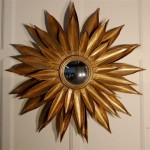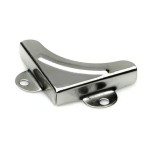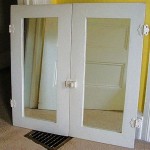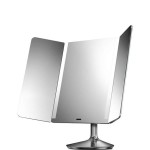Can You Put A Large Mirror In A Small Room? Exploring the Illusion of Space
The question of whether a large mirror can be effectively utilized in a small room is a common interior design consideration. While intuitively it might seem counterproductive to place a substantial reflective surface within limited confines, the strategic application of mirrors can yield surprisingly positive results, significantly altering the perception of space and light.
The effectiveness of using a large mirror in a small room hinges on several factors, including the size and shape of the mirror, its placement within the room, and the elements it reflects. A poorly positioned or inappropriately sized mirror can exacerbate the feeling of claustrophobia; however, when employed thoughtfully, a large mirror becomes a potent tool for visual expansion.
Mirrors work by creating an optical illusion, extending the perceived boundaries of a space. The reflection tricks the eye into believing the room is larger than its actual dimensions. This technique is particularly useful in areas where square footage is limited, such as apartments, small bedrooms, and narrow hallways.
Maximizing the Illusion: Strategic Mirror Placement
The location of the mirror is paramount. Placing a large mirror on a wall that is directly opposite or adjacent to a window is often the most effective strategy. This configuration allows the mirror to reflect natural light throughout the room, significantly brightening the space and creating a more airy atmosphere. The reflected light reduces shadows and dark corners, further contributing to the illusion of spaciousness.
Alternatively, a large mirror can be placed on a wall that is visually obstructed or that leads to another room. For instance, in a narrow hallway, a full-length mirror placed at the end can suggest a continuation of the space beyond the wall, effectively doubling the perceived length of the hallway. Similar principles apply to small living rooms or bedrooms where a mirror can reflect a portion of the existing room, creating a sense of increased depth.
However, the content reflected must be carefully considered. A mirror facing a cluttered or unattractive area will only amplify the negative aspects of the room. Therefore, it is crucial to ensure that the mirror reflects a visually appealing portion of the space, focusing on features like artwork, a well-arranged seating area, or a view of the outdoors.
Furthermore, the height of the mirror should be taken into account. A full-length mirror, reaching from floor to ceiling, typically provides the most dramatic effect in terms of visual expansion. However, in some cases, a smaller mirror that is strategically positioned can be more appropriate. The height should be proportional to the size of the room and the objects it reflects.
Size and Shape Considerations: Proportionality and Design
While a large mirror is generally recommended for maximizing the illusion of space, it is important to maintain proportionality. A mirror that is excessively large for the room can become overwhelming and visually jarring. The size of the mirror should be balanced with the dimensions of the wall it occupies and the overall scale of the room's furnishings.
The shape of the mirror can also influence its impact. Rectangular mirrors are generally preferred for creating a sense of height and length, while square or circular mirrors can add a touch of visual interest and break up the monotony of a rectangular space. The choice of shape depends on the desired aesthetic and the overall design scheme of the room.
Frameless mirrors offer a seamless and modern look, blending seamlessly into the wall and minimizing visual clutter. Framed mirrors, on the other hand, can add a decorative element and complement the room's style. The frame should be chosen carefully to ensure it does not overpower the space or clash with the existing decor.
Multiple smaller mirrors can also be used to achieve a similar effect, albeit in a more subtle manner. Grouping several smaller mirrors together can create a gallery-like effect and add visual texture to the wall. This approach is particularly suitable for rooms with limited wall space or for those who prefer a more eclectic design style.
Addressing Potential Drawbacks: Avoiding Distortion and Over-Reflection
Although the use of large mirrors in small rooms can be highly effective, it is important to be aware of potential drawbacks. One common issue is distortion. Poor quality mirrors can distort the reflection, creating an unsettling and disorienting effect. It is essential to invest in high-quality mirrors that provide a clear and accurate reflection.
Another potential problem is over-reflection. If a room is excessively cluttered or filled with reflective surfaces, the mirror can amplify the chaos and create a visually overwhelming environment. To avoid this, it is important to declutter the space and minimize the number of reflective surfaces. Soft textures, such as rugs and curtains, can help to absorb sound and reduce the amount of light reflected in the room.
Mirrors can also create glare, especially in rooms with direct sunlight. To mitigate this, consider using window treatments, such as blinds or curtains, to control the amount of sunlight entering the room. Positioning the mirror away from direct sunlight can also help to reduce glare.
Furthermore, avoid placing a mirror directly opposite the entrance to a room. This can create a disconcerting effect for those entering the space, as they may be startled by their own reflection. It is generally preferable to position the mirror on a side wall or in a location that is less likely to cause surprise or discomfort.
The psychological impact of mirrors should also be considered. While mirrors can enhance the perception of space, they can also make individuals more self-conscious about their appearance. If this is a concern, consider using tinted mirrors or positioning the mirror in a location where it is less likely to be used for self-reflection.
Ultimately, the decision of whether to use a large mirror in a small room depends on the specific characteristics of the space and the individual's design preferences. By carefully considering the size, shape, placement, and content of the reflection, it is possible to harness the power of mirrors to create a more spacious, brighter, and visually appealing environment.

20 Incredibly Clever Ways To Decorate With Mirrors In A Small Living Room Michael Helwig Interiors

Enhance Small Spaces With Mirrors 8 Strategic Placement Ideas

Make Small Rooms Look Bigger With Mirrors Murphy Door

4 Ways To Make A Small Room Feel Big With Mirrors

How To Use Large Mirrors Make Space In A Small Home

Enhance Small Spaces With Mirrors 8 Strategic Placement Ideas

20 Incredibly Clever Ways To Decorate With Mirrors In A Small Living Room Michael Helwig Interiors

Remodeling Tips 7 Ways To Make A Small Room Feel Larger
:strip_icc()/cdn.cliqueinc.com__cache__posts__199530__this-one-trick-will-make-every-small-room-seem-larger-1858904-1470327592.700x0c-fc6fb59e4cde491494733a1cf007e476.jpg?strip=all)
8 Gorgeous Small Space Ideas

Creating Spacious Illusions How Mirrors Enlarge Your Space In Interior Design The Carpet Palace Flooring Super







